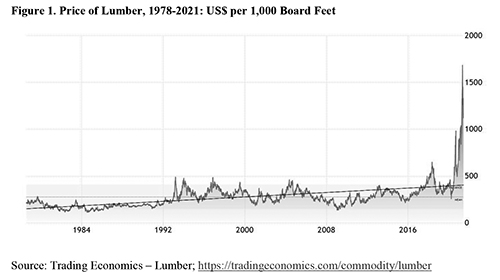
WILLIAM RAU
When the annual World Economic Forum draws the wealthy and powerful to Davos, Switzerland, things happen. The 2019 initiation of a 1 trillion tree planting scheme (https://www.1t.org/) – 1t for short – is an example. Does it mean that the Davos Elite have become tree huggers?
1t’s Investing in Forests offers clues. To begin, 1t avoids crucial definitions for forests and afforestation. Does 1t default to United Nations definitions? If it does, the UN’s definitional laxness allows tree plantations to count as “forests” and receive carbon-reduction credits under the 2015 Paris Climate Accord. Afforestation, mass plantings of trees where they never grew before, also receive credits.
Afforestation is weird. Its American origin begins in John Fenimore Cooper’s The Prairie (1827). Set in Nebraska, Cooper exploits the state’s treeless expanses metaphorically as “barren wastelands” to attack the “Yankee choppers” who were destroying eastern forests. J. Sterling Morton, the Nebraskan founder of Arbor Day, took the metaphor literally. A strong proponent of manifest destiny, he assigned Anglo Saxons the duty to put Nebraskan soil to ‘good use’ by removing both prairie and Native Americans. Arbor Day was a means for him to push large-scale tree plantings where they did not belong, in treeless prairie biomes with their own ecological integrity.
Last month we saw the massive failure afforestation brought to China’s planting of a huge shelterbelt of aspens, willows, etc., to curtail Gobi Desert sandstorms. About 85% of the billions of trees planted are dying off, but not before some trees lowered the water table so much that it will be a long time before native grasses can grow back, if ever. Another failure involves Africa’s Great Green Belt, in this case a 10-mile wide, 4,000-mile long tree shelterbelt in the Sahel just south of the Sahara and extending from the Atlantic to Indian Oceans. Once more, about 85% of planted saplings died off. However, no one matches Turkey’s Guinness World Record for the speed of planting trees. For some reason, Turkey did not apply for another Guinness Record when 10 million of the 11 million saplings were dead only months after planting – another speed record.
Unlike afforestation failures, Investing in Forests is a flexible document with many potential paths for “success.” Some corporations may offer major decision-making roles for forest-dependent dwellers and seek to preserve and expand existing forests. Others will clear-cut old-growth forests for supersized profits, evict any indigenous inhabitants, and then replant fast-growing, non-native tree monocultures for the speedy realization of new lumber sales.

Investing in Forests emphasizes both investment profitability and the carbon credits they will generate for businesses. As the explosive, post-2015 increase in lumber prices shows (Figure 1), “Yankee choppers” will earn fantastic profits by clear-cutting existing forests. Replanting vast tree monocultures, which will be clear-cut in another 10-20 years, will release more carbon than they store while killing native wildlife by eliminating their food supplies.
If fake-forest carbon credits delay reductions in carbon emissions, they will also kill off the planet. For 2009-2018, fossil-fuel emissions generated 9.5 gigatons of carbon annually while forests and grasslands absorbed about 3.2 gigatons. Forests cannot substitute for the rapid abolition of fossil fuels.
Next month I turn to forest- and farmer-assisted natural regeneration of trees. It’s faster, better, cheaper.
References
1t.org. 2021 (Jun). Investing in Forests: The Business Case. World Economic Forum; https://www.weforum.org/reports/investing-in-forests-the-business-case
Bristow, David L. 2019 (Mar 29). Was J. Sterling Morton a racist? Here’s what the Arbor Day founder said and did. Nebraska History; https://history.nebraska.gov/blog/was-j-sterling-morton-racist-here%E2%80%99s-what-arbor-day-founder-said-and-did
Forrester, Nikki. 2020 (Jun 11). The potentials and limitations of tree plantings as a climate solution. Climate Feedback; https://climatefeedback.org/the-potentials-and-limitations-of-tree-plantings-as-a-climate-solution/
Greenpeace. 2020 (Jul 20). Planting Tree Farms: No Panacea for Climate Crisis; https://issuu.com/greenpeace_eastasia/docs/planting_tree_farms_no_panacea_for_climate_crisis
Helzer, Chris. 2021 (Apr 26). The Darker Side of Tree Planting in the Great Plains. Prairie Ecologist; https://prairieecologist.com/2021/04/26/the-darker-side-of-tree-planting-in-the-great-plains/
Kent, Sami. 2020 (Jan 30). Most of 11m trees planted in Turkish project ‘may be dead’. Guardian; https://www.theguardian.com/world/2020/jan/30/most-of-11m-trees-planted-in-turkish-project-may-be-dead
MacDougall, Hugh C. 1999. James Fenimore Cooper: Pioneer of the Environmental Movement. Adirondack Club. Oneonta, NY; https://www.jfcoopersociety.org/articles/INFORMAL/HUGH-ENVIRONMENT.HTML
Veldman, Joseph W., et al. 2015 (Jan 30). Tyranny of trees in grassy biomes. Science; https://www.researchgate.net/publication/271592246_Tyranny_of_trees_in_grassy_biomes
